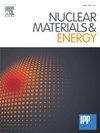Net lithium deposition and dominant self-sputtering in lithium tokamak experiment-β with a liquid lithium wall
IF 2.3
2区 物理与天体物理
Q1 NUCLEAR SCIENCE & TECHNOLOGY
引用次数: 0
Abstract
We observed enhanced net lithium deposition and lithium erosion, possibly dominated by physical sputtering of lithium by lithium-ion bombardment, on the outer plasma-facing surface in the Lithium Tokamak eXperiment-β (LTX-β) during liquid lithium wall operations. Silicon crystal samples with micro-trenches (30 μm × 30 μm × 2–7 μm deep) were exposed to hydrogen plasmas in LTX-β for solid and liquid lithium wall operations. Post-mortem analysis using X-ray photoelectron spectroscopy combined with argon ion sputtering measured net lithium deposition of 8.2 or 21 nm on the silicon crystal surface exposed for ∼ 50 repeated shots of ∼ 50-ms hydrogen plasma discharges during the liquid lithium wall operations at a vessel temperature of 475 K. Energy dispersive X-ray spectroscopy measured oxygen concentration patterns on the micro-trench floors, which were due to oxidized lithium deposition. Using the inhomogeneous oxygen concentration pattern caused by an ion-shadowing effect associated with the micro-trench’s geometric structure, we determined a polar incident ion direction of 68.4 ± 1.6° referenced to the surface normal direction. This observation was well-explained by the hypothesis that self-sputtering of Li was a dominant lithium erosion source in addition to lithium sputtering by hydrogen bombardment.
求助全文
约1分钟内获得全文
求助全文
来源期刊

Nuclear Materials and Energy
Materials Science-Materials Science (miscellaneous)
CiteScore
3.70
自引率
15.40%
发文量
175
审稿时长
20 weeks
期刊介绍:
The open-access journal Nuclear Materials and Energy is devoted to the growing field of research for material application in the production of nuclear energy. Nuclear Materials and Energy publishes original research articles of up to 6 pages in length.
 求助内容:
求助内容: 应助结果提醒方式:
应助结果提醒方式:


